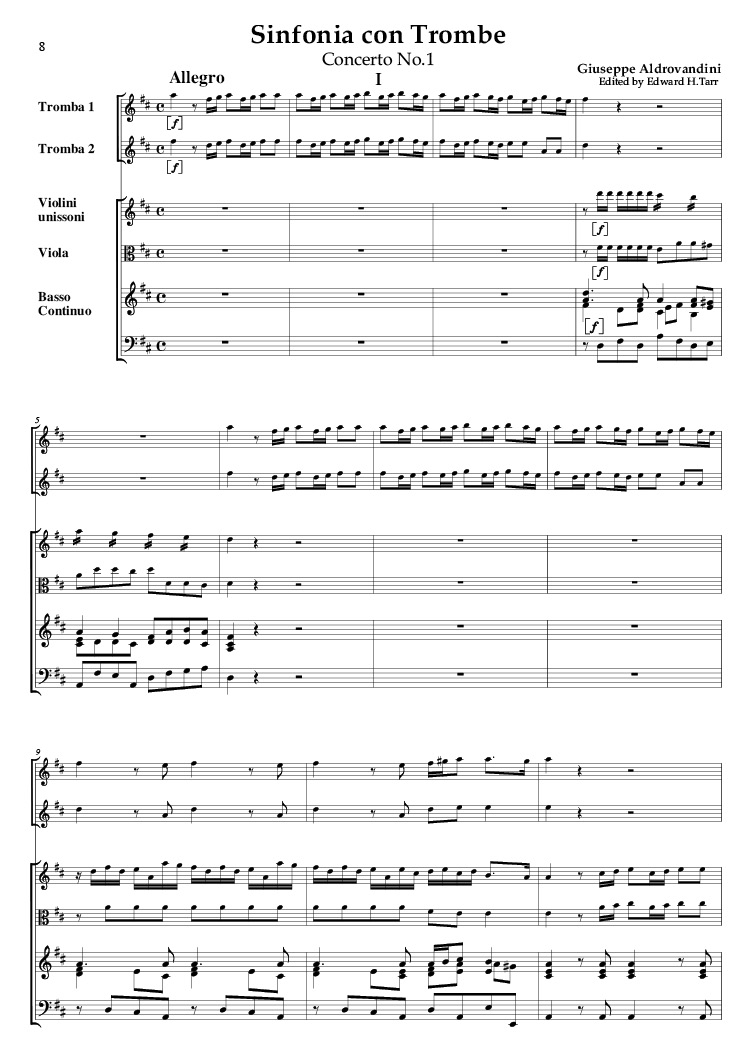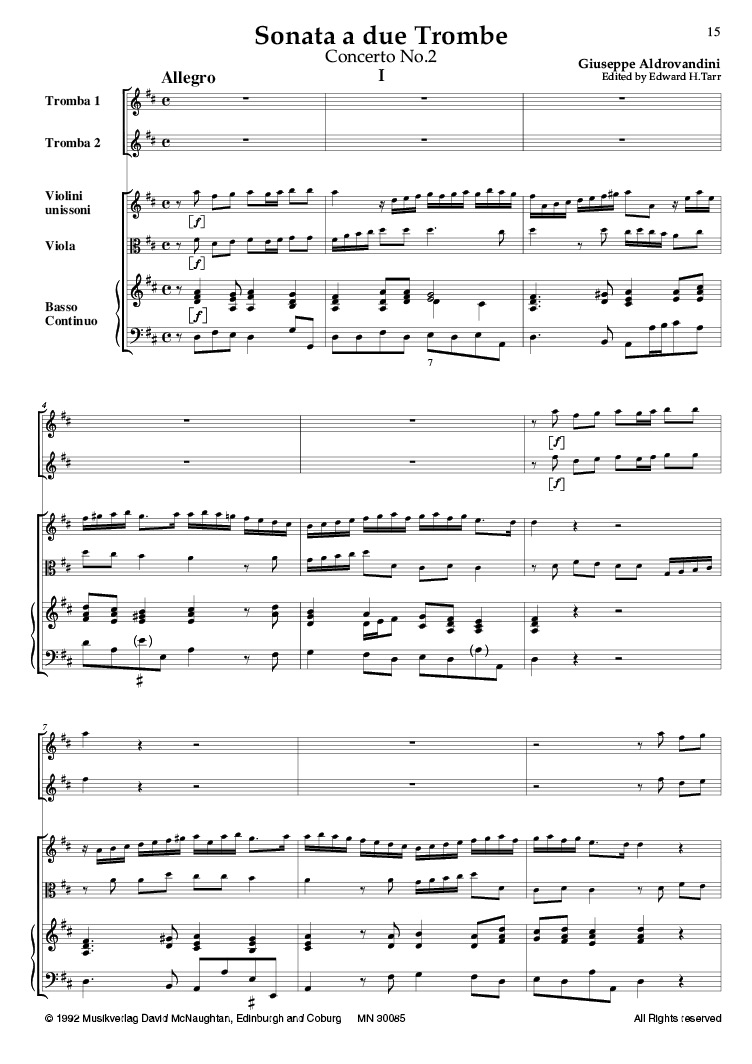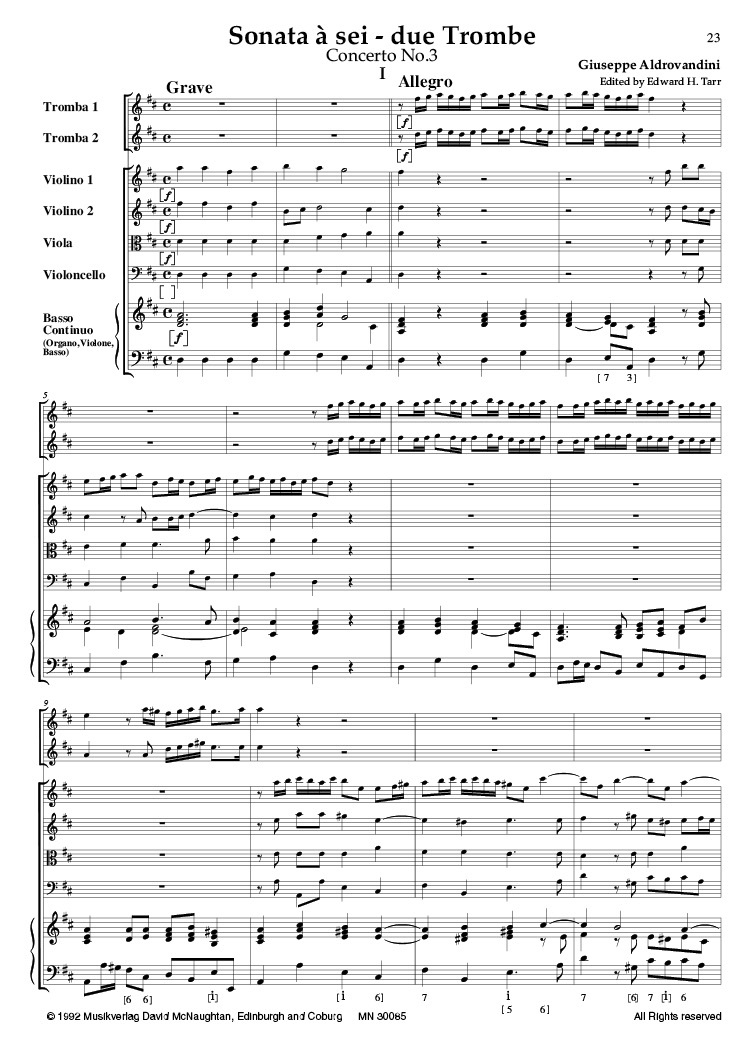
Aldrovandini Tre Concerti per due Trombe
Instrumentation: 2 Trumpets, Strings, B.c.Parts included: 2x Trumpets in D, 2x Trumpets in high A (Double Parts), Strings 4324, 2x B.c./Score
Difficulty (I-VI): IV
Editor: Edward H. Tarr
The construction of the grand Basilica of Saint Petronius in Bologna was begun in 1390, and the church was intended to become the largest in all Christendom. However, in 1563 the Roman Curia decided differently, so that what was originally planned as the transept became the nave. The church as it now stands, finished after nearly three centuries of construction, is nevertheless enormous. The nave is 132m long and 44m high; with the aisles the basilica is 60m wide. In 1669-70 the choir area behind the high altar was expanded, making room for a large number of musicians.
Although the church's regular orchestra consisted of 10 to 15 members during the 17th and early 18th centuries, from 1657 onwards extra musicians were hired in large numbers for great feast days such as Easter and, in particular, that of the name day of the town's patron saint, Petronius, on the 4th of October. Our cover illustration shows the placement of the musicians on the 4th of October, 1722. Approximately sixty musicians can be seen between the two historical organs from 1483 and 1596, whereby the surviving record of payments for that day show that in actuality some 141 musicians were engaged. The large number of performers not only corresponded to the vastness of the basilica, it was also an acoustical necessity.
In this church under three chapelmasters - Maurizio Cazzati (served 1657-71), Giovanni Paolo Colonna (served 1674-95), and Giacomo Antonio Perti (served 1696-1756) -- more sonatas, sinfonias, and concertos for trumpets were performed than at any other place. The editor' s own practical experience gained in concerts on historical instruments in S. Petronio from 1984 on leads him to believe that composers introduced the trumpet for acoustical reasons besides the obvious symbolic ones: in the vast church it is the only instrument whose sound carries clearly. In 1663 under Canati, 28 regular and 58 extra musicians (altogether 86 singers and instrumentalists) are documented; under Colonna in 1687 there were 106 and in 1694, 105. On these three grand occasions the orchestra, without the singers, had a strength of 18, 31, and 40 members. The chief musical event was a concerted mass in which trumpets frequently played, a prelude in the form of a trumpet sonata often preceding it. Vesper psalms, too, were performed with trumpets.
The solo trumpeters were not members of the Cappella di S. Petronio, but were extras from Modena or in the employ of the Archbishop. They only begin to be documented in 1676. From 1679 to 1699 the trumpeter who was especially engaged for these festive occasions was Giovanni Pellegrino Brandi. Between 1704 and 1707 an anonymous trumpeter of the archbishop played together with a certain Angellino (who played first in 1703, and second 1704-05) and one Sellaro or Selloro (1706-07).
Aldrovandini Tre concerti
Aldrovandini was born in 1672 or 1673 in Bologna and studied with the long-lived G. A. Perti (1661-1756), maestro di cappella first at S. Pietro (1690), then at S. Petronio (from 1696 to his death). Two of Aldrovandini's oratorios were performed in 1691, and four years later he became a member of the Accademia Filarmonica, becoming its head ("principe") in 1702. From that year on, he was also honorary maestro di cappella to the Duke of Mantua, and later he was also a member of the Accademia del Santo Spirito in Ferrara. In addition and in the best Bolognese tradition, he wrote three sonatas for trumpet, strings, and continuo, and three more for two trumpets, strings, and continuo, the latter of which are published here for the first time complete and in their original key of D major.



